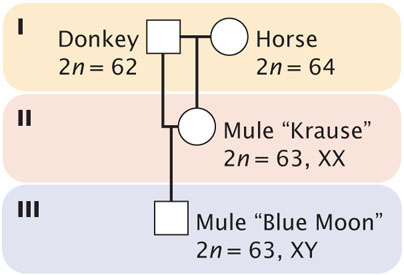Challenge Questions
Section 8.3
Question 8.45
Red-green color blindness is a human X-linked recessive disorder. Jill has normal color vision, but her father is color blind. Jill marries Tom, who also has normal color vision. Jill and Tom have a daughter who has Turner syndrome and is color blind.
- a. How did the daughter inherit color blindness?
- b. Did the daughter inherit her X chromosome from Jill or from Tom?
Question 8.46
 Progeny of triploid tomato plants often contain parts of an extra chromosome, in addition to the normal complement of 24 chromosomes (J. W. Lesley and M. M. Lesley. 1929. Genetics 14:321–336). Mutants with a part of an extra chromosome are referred to as secondaries. James and Margaret Lesley observed that secondaries arise from triploid (3n), trisomic (3n + 1), and double trisomic (3n + 1 + 1) parents, but never from diploids (2n). Give one or more possible reasons that secondaries arise from parents that have unpaired chromosomes but not from parents that are normal diploids.
Progeny of triploid tomato plants often contain parts of an extra chromosome, in addition to the normal complement of 24 chromosomes (J. W. Lesley and M. M. Lesley. 1929. Genetics 14:321–336). Mutants with a part of an extra chromosome are referred to as secondaries. James and Margaret Lesley observed that secondaries arise from triploid (3n), trisomic (3n + 1), and double trisomic (3n + 1 + 1) parents, but never from diploids (2n). Give one or more possible reasons that secondaries arise from parents that have unpaired chromosomes but not from parents that are normal diploids.
Question 8.47
 Mules result from a cross between a horse (2n = 64) and a donkey (2n = 62), have 63 chromosomes, and are almost always sterile. However, in the summer of 1985, a female mule named Krause who was pastured with a male donkey gave birth to a newborn foal (O. A. Ryder et al. 1985. Journal of Heredity 76:379–381). Blood tests established that the male foal, appropriately named Blue Moon, was the offspring of Krause and that Krause was indeed a mule. Both Blue Moon and Krause were fathered by the same donkey (see the illustration). The foal, like his mother, had 63 chromosomes—half of them horse chromosomes and the other half donkey chromosomes. Analyses of genetic markers showed that, remarkably, Blue Moon seemed to have inherited a complete set of horse chromosomes from his mother, instead of the random mixture of horse and donkey chromosomes that would be expected with normal meiosis. Thus, Blue Moon and Krause were not only mother and son, but also brother and sister.
Mules result from a cross between a horse (2n = 64) and a donkey (2n = 62), have 63 chromosomes, and are almost always sterile. However, in the summer of 1985, a female mule named Krause who was pastured with a male donkey gave birth to a newborn foal (O. A. Ryder et al. 1985. Journal of Heredity 76:379–381). Blood tests established that the male foal, appropriately named Blue Moon, was the offspring of Krause and that Krause was indeed a mule. Both Blue Moon and Krause were fathered by the same donkey (see the illustration). The foal, like his mother, had 63 chromosomes—half of them horse chromosomes and the other half donkey chromosomes. Analyses of genetic markers showed that, remarkably, Blue Moon seemed to have inherited a complete set of horse chromosomes from his mother, instead of the random mixture of horse and donkey chromosomes that would be expected with normal meiosis. Thus, Blue Moon and Krause were not only mother and son, but also brother and sister.
- a. With the use of a diagram, show how, if Blue Moon inherited only horse chromosomes from his mother, Blue Moon and Krause are both mother and son as well as brother and sister.
- b. Although rare, additional cases of fertile mules giving births to offspring have been reported. In these cases, when a female mule mates with a male horse, the offspring is horselike in appearance but, when a female mule mates with a male donkey, the offspring is mulelike in appearance. Is this observation consistent with the idea that the offspring of fertile female mules inherit only a set of horse chromosomes from their mule mothers? Explain your reasoning.
- c. Can you suggest a possible mechanism for how the offspring of fertile female mules might pass on a complete set of horse chromosomes to their offspring?

Section 8.4
Question 8.48
Humans and many other complex organisms are diploid, possessing two sets of genes, one inherited from the mother and one from the father. However, a number of eukaryotic organisms spend most of their life cycles in a haploid state. Many of these eukaryotes, such as Neurospora and yeast, still undergo meiosis and sexual reproduction, but most of the cells that make up the organism are haploid.
Considering that haploid organisms are fully capable of sexual reproduction and generating genetic variation, why are most complex eukaryotes diploid? In other words, what might be the evolutionary advantage of existing in a diploid state instead of a haploid state? And why might a few organisms, such as Neurospora and yeast, exist as haploids?
Go to your  to find additional learning resources and the Suggested Readings for this chapter.
to find additional learning resources and the Suggested Readings for this chapter.